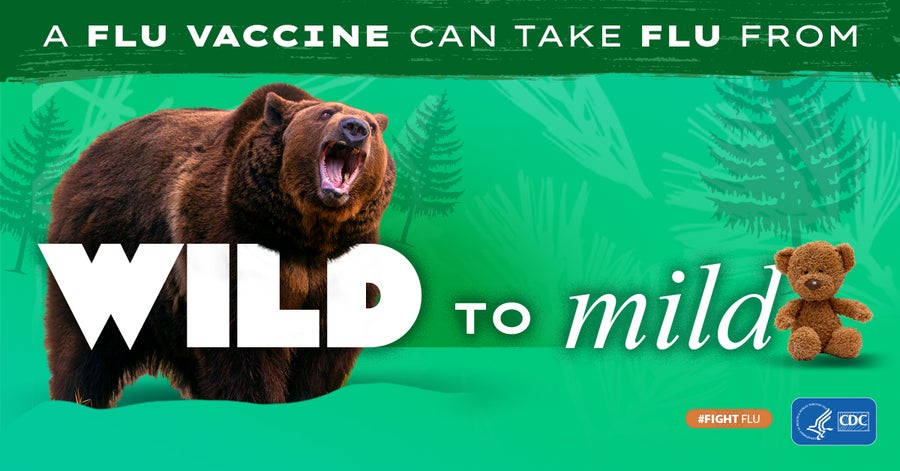It’s like clockwork: first comes a brisk fall breeze, then comes the public health push to get a flu shot. But the U.S. Centers for Disease Control and Prevention’s messaging this year might look a little different from previous vaccination seasons. The agency has launched a messaging campaign dubbed “Wild to Mild” that uses adorable critters to illustrate how a vaccine can tame a bout with the flu by reducing its strength from that of an elephant or a lion to that of a mouse or a kitten.
The framing might come as a surprise to those used to a blunter way of talking about vaccines: get vaccinated or get sick. But Wild to Mild is designed to be a more honest, nuanced portrayal of the benefits of the influenza vaccine, which scientists have long recognized is better at reducing serious infections than at preventing infection altogether.
“We tend to take kind of a black-and-white approach to vaccines of ‘if you get vaccinated, it will keep you from getting that particular disease,’” says Sarah Bauerle Bass, a social and behavioral scientist at Temple University, who focuses on health and risk communication. “The pro is that it’s a very simple message; the con is that it doesn’t necessarily communicate the reality of vaccines, which is that sometimes you do get that disease even though you’re vaccinated.”
On supporting science journalism
If you're enjoying this article, consider supporting our award-winning journalism by subscribing. By purchasing a subscription you are helping to ensure the future of impactful stories about the discoveries and ideas shaping our world today.
The amount of protection a vaccine offers depends on the disease it targets. For some shots, such as those for measles and polio, the black-and-white approach is essentially true, says William Schaffner, a professor of infectious diseases at Vanderbilt University. If you received the standard vaccine regimen as a child, your odds of ever catching those particular diseases are tiny: around 1 percent for each.
But flu doesn’t work the same way. Measles and polio are static viruses, whereas influenza mutates regularly, allowing it to evade our immune system even if it’s been trained to identify the pathogen via prior infection or vaccination. In addition, influenza is a family of viruses, and typically the flu vaccine administered in the U.S. targets only four strains. These strains are selected based on the ones that are circulating in the Southern Hemisphere more than six months before flu season begins in the North. Selecting which strains to target is a guessing game—one that scientists can’t always win.

These factors give the influenza vaccine a spotty record in preventing disease—at least to an untrained eye. “During well-matched seasons, we see [risk reduction] numbers pretty consistently within the range of 40 to 60 percent” among the vaccinated, says Erin Burns, associate director of communications for the influenza division at the CDC. “I think the public perception, maybe, is that that is less than impressive.”
The perceived “low” protection can cause people to hesitate about receiving the vaccine. “There’s a very widely held perception that the flu vaccine doesn’t work,” she says. “People think that if they get vaccinated, and then they get sick, the vaccine has failed.”
But that’s not an accurate view of what public health experts expect the flu vaccine to accomplish, Schaffner says, adding that he’s been encouraging the messaging pivot for years now. Mild influenza occurs mostly in the respiratory tract, where vaccine-induced defenses aren’t as effective because they can’t reach the surface of the mucus membranes in, for example, your nose, he says. That’s where the virus might first enter your body and cause flu’s mild symptoms, such as a runny nose—so vaccination doesn’t do much against these infections.
Instead the vaccine produces defenses that are active deeper in the body—in the heart, liver and kidney, for example—and can stop the virus from sneaking into organs, where it can cause a severe to possibly life-threatening infection. For the flu, vaccination isn’t about reducing infections overall but instead about reducing the hundreds of thousands of hospitalizations and tens of thousands of deaths the disease causes in the U.S. each year.
The Wild to Mild campaign, Burns says, is designed to counter the idea that the flu vaccine doesn’t work and present a more accurate understanding of the shot’s purpose. “We were realizing that we needed to reset those expectations,” she says. She isn’t concerned that advertising the fact that the flu vaccine doesn’t offer total protection could reduce uptake because the perception of its failure is already so widespread.
The Wild to Mild approach also addresses another common misperception: that the flu isn’t a serious illness. CDC scientists are “emphasizing the severity of the disease without scaring people, and they’re empowering [people],” says Saad Omer, an epidemiologist and dean of the O’Donnell School of Public Health at the University of Texas Southwestern. “They’re saying, ‘It can be wild, but you can make it mild because you have the power to do that.’”
Howard Markel, a physician and historian of medicine at the University of Michigan, says he sees a dramatic shift in the way the public has come to think about vaccines in general. “If you grew up in the 1940s, 1950s and 1960s, vaccines were like a gift,” Markel says. Shots were also mostly for children then, he notes, unlike the modern flu vaccine, with its annual campaigns targeting all adults.
Now public perception of vaccines in general is much more neutral—and, in some cases, deeply skeptical—and views are politically polarized. “Our tolerance is less, too, for any error [or] anything less than perfection in our science and medicine,” he says.
Meanwhile the CDC has struggled to sell some Americans on COVID vaccines—particularly in the form of annual shots that are available each fall, like the flu vaccine is. Temple University’s Bass says that the COVID vaccine has suffered from the same perception of ineffectiveness as the flu vaccine for similar reasons.
Burns says the Wild to Mild campaign came about independently from the agency’s COVID experience, although flu vaccine uptake rates have dipped slightly since the pandemic’s first winter. “People are still more open to flu vaccines than they are to COVID vaccines,” she says.
Still, public health officials acknowledge that some people will never get the flu vaccine, and they are focusing on vaccine education that will help increase uptake among undecided people. “You go into these campaigns knowing that you’re never going to get 100 percent of people,” Bass says. “What you’re really aiming for is that large group in the middle who might, with either the right messaging or the right messengers, be more likely to do that.”
In that way, Wild to Mild is an uncanny embodiment of the flu vaccine itself, which can’t prevent all infections but can nonetheless reduce the disease’s impacts. “We can do a lot of good with this vaccine,” Schaffner says. “We can turn wild to mild while we’re waiting for the perfect science to give us the perfect flu vaccine. It’s not here yet. Let’s do the best we can with what we have today.”
